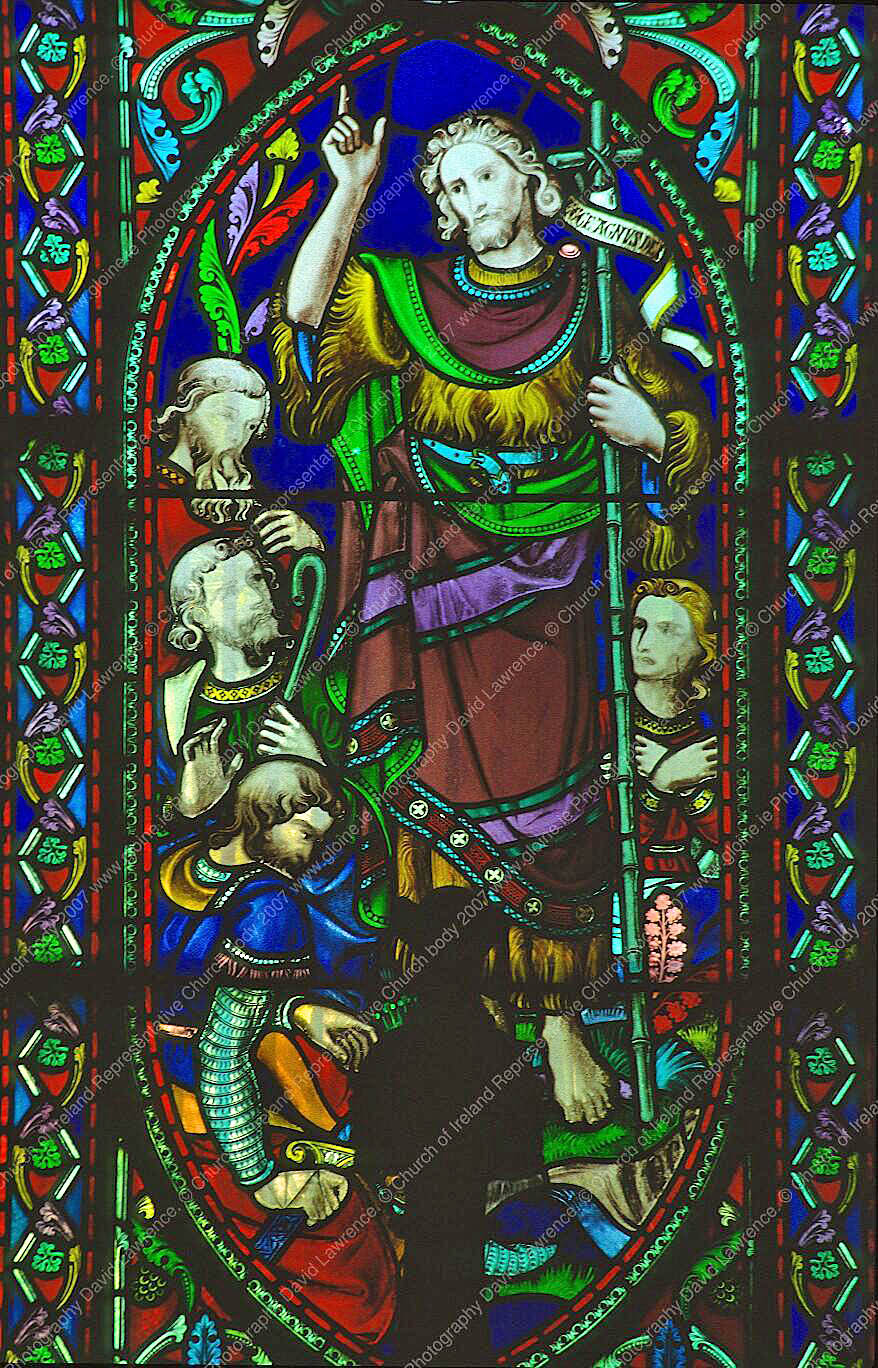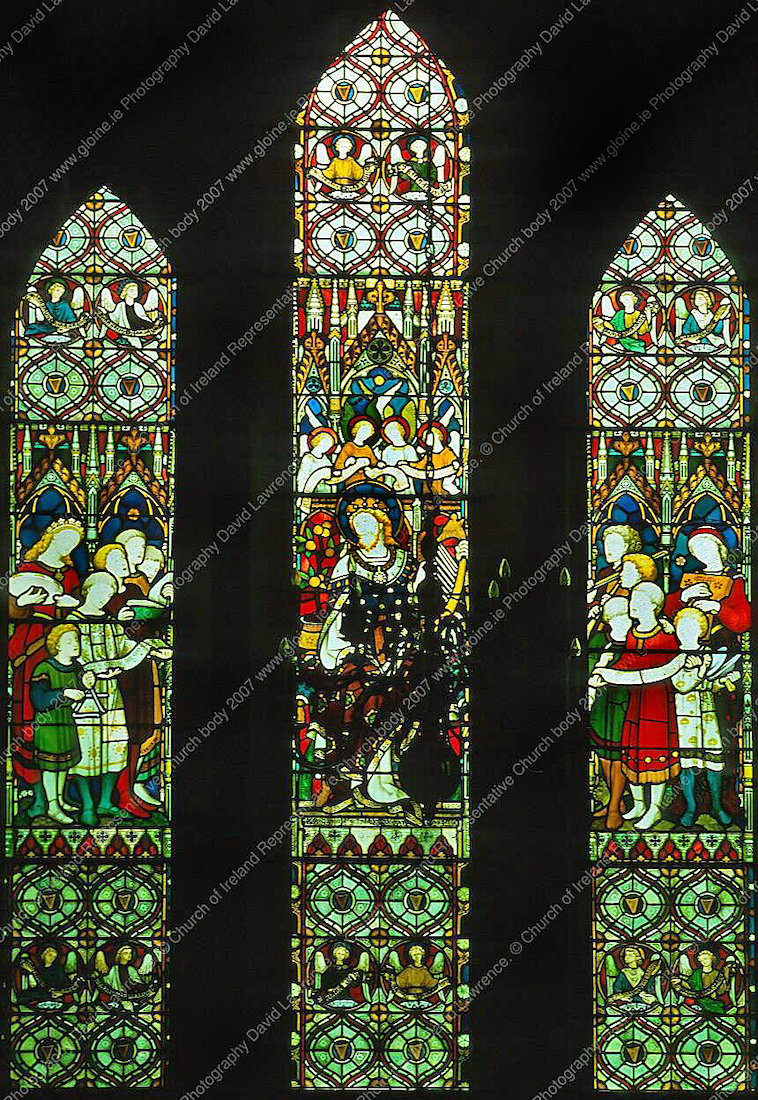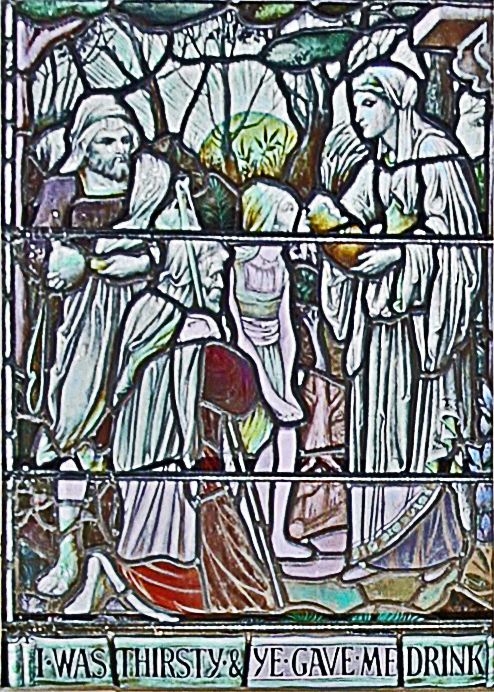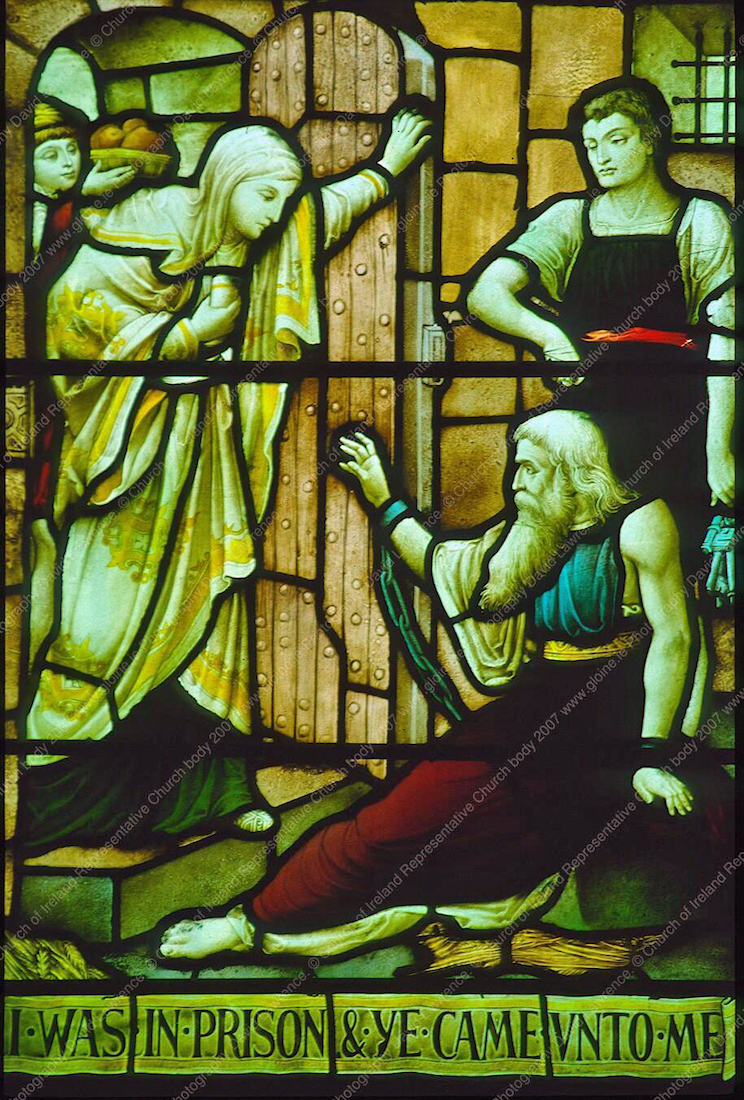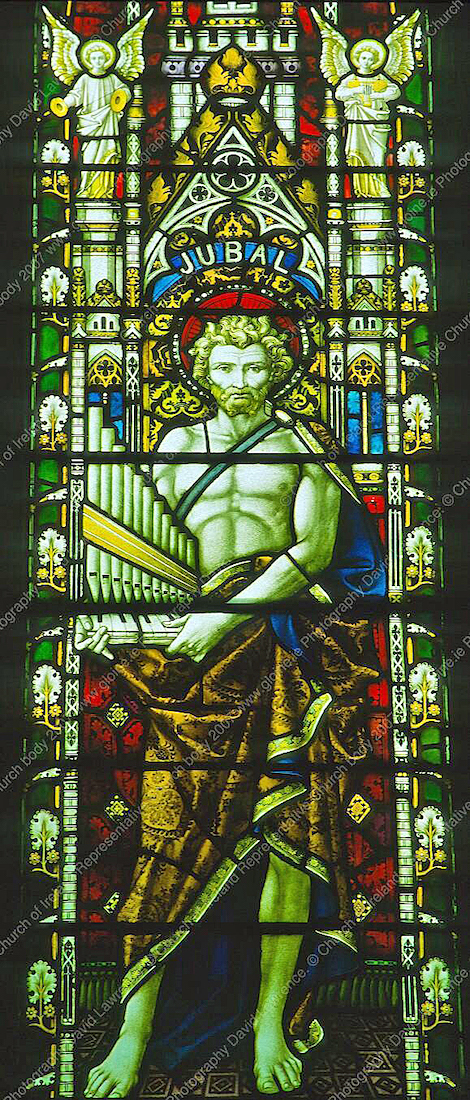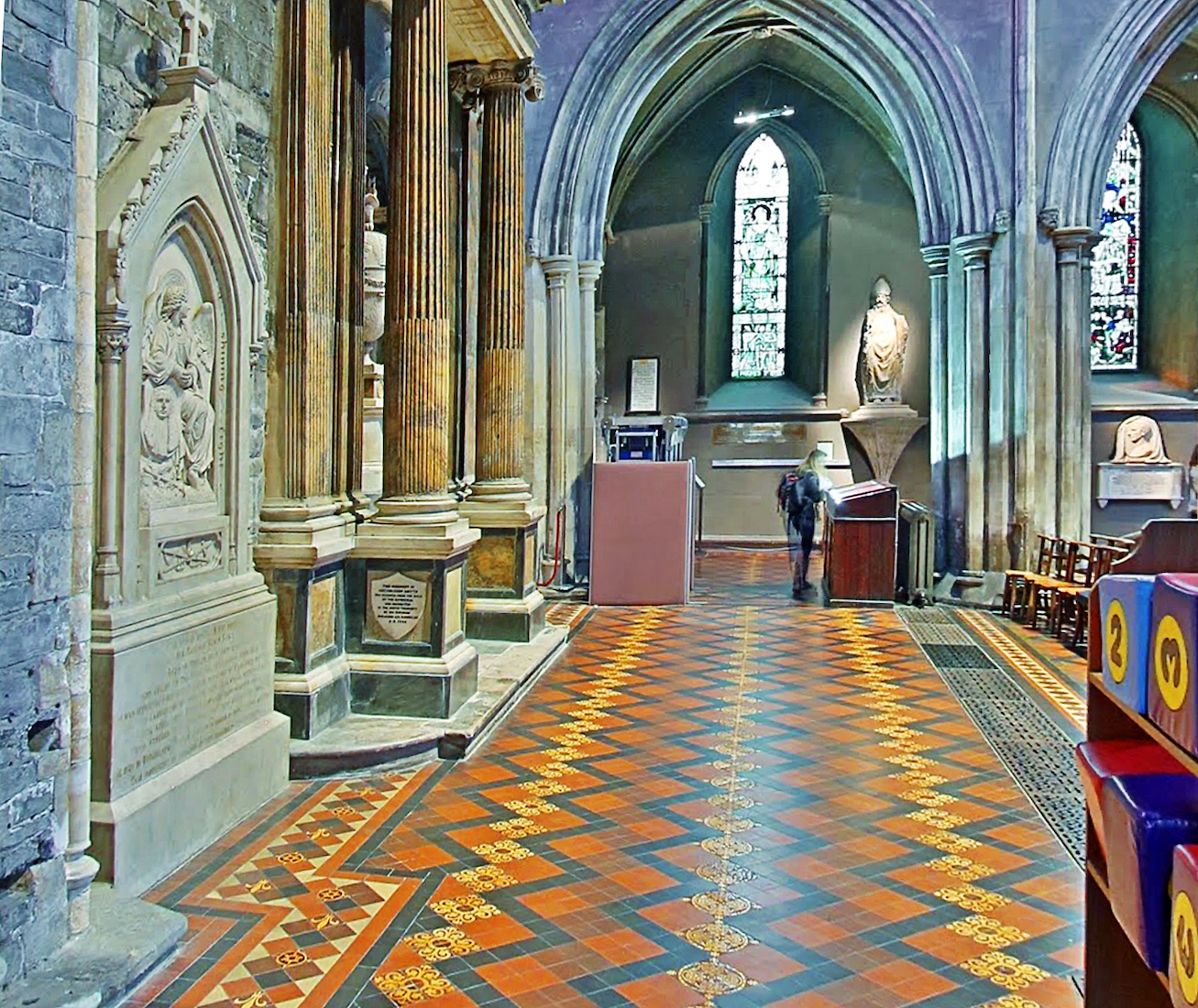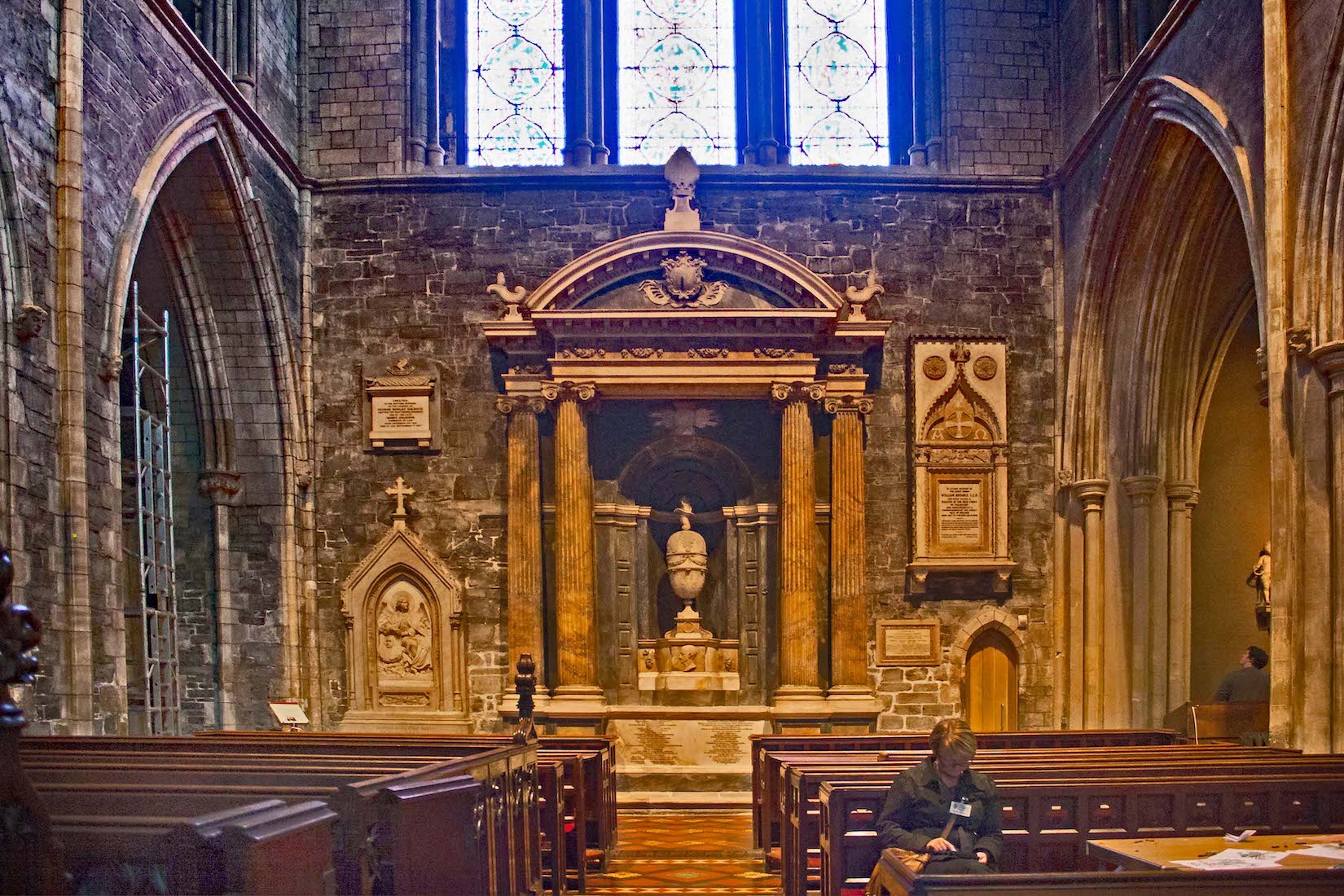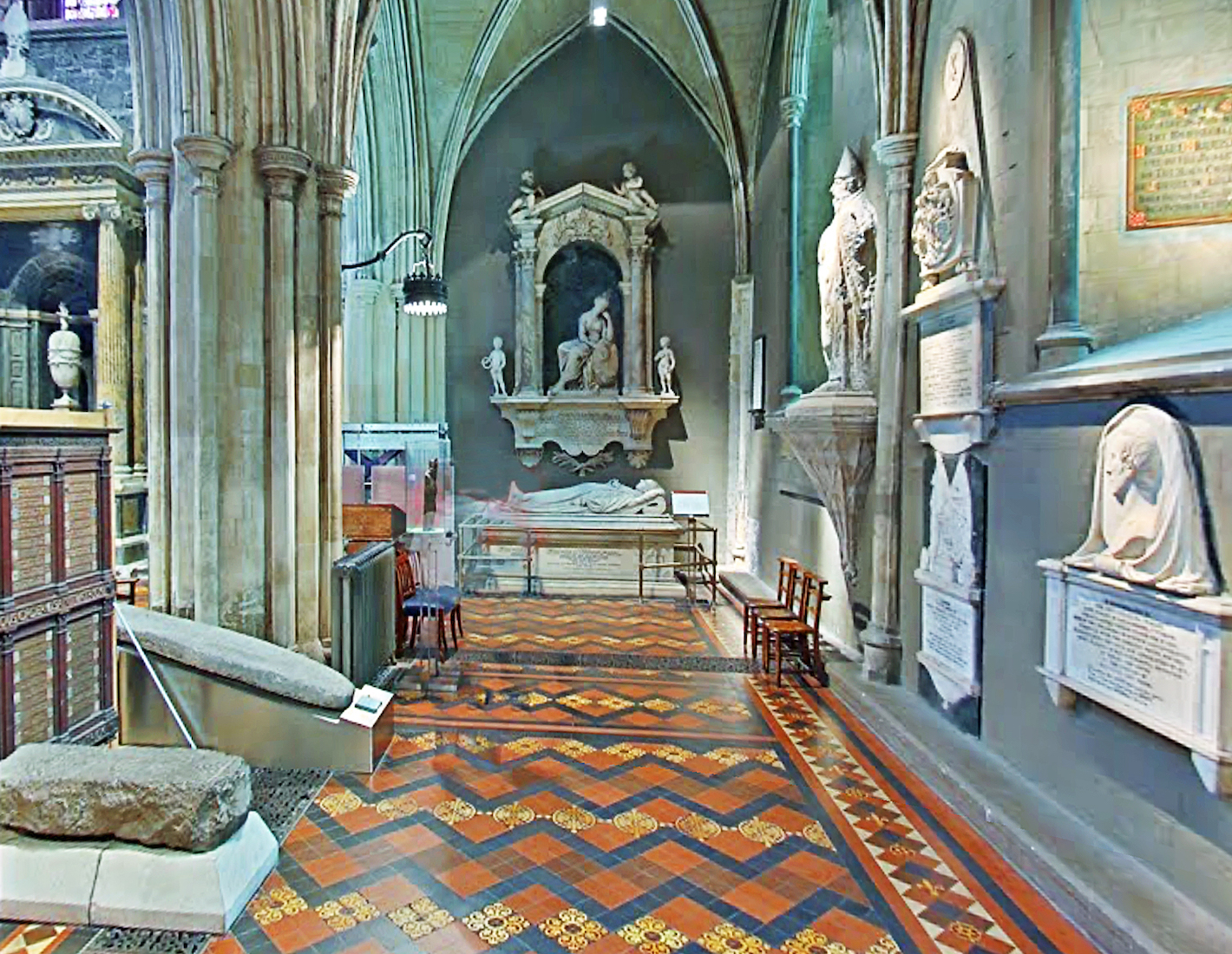62. LADY CHAPEL ALTAR GSV

Below the East window is a raised platform with a simple altar which stands in front of an attractive little reredos. A shelf in front of the reredos bears a cross and two candles.
63. LADY CHAPEL EAST WINDOWS WG(X7)
Here are the scenes from the three lancets of the central East window of the Lady Chapel. Reference to #60 may help to clarify this collection. These panels show, from left to right: •• Christ as Good Shepherd (top), Melchizedek (bottom); •• Baptism of Christ (top), King Solomon Building the Temple (centre), St John the Baptist (bottom); •• Christ Blessing Children (top), Moses (bottom).The window was made in 1865 by William Wailes, Newcastle-upon-Tyne.
64. LADY CHAPEL SOUTH WINDOWS WG(X8)
We see here scenes from the South windows of the Lady Chapel. Vertical panels from left: Christ with Martha (top), Christ Healing the Man at the Pool of Bethesda (middle), Christ Healing the Mother-in-Law of St Peter (bottom). •• Risen Christ Appears to Mary Magdalene (top), Christ Healing the Daughter of the Syrophonecian Woman (middle), Christ Healing the Paralytic (bottom) •• Risen Christ (top), Christ as Salvador Mundi. •• Christ as Bread of Life, Supper at Emmaus. All the panels are by Clayton and Bell, London and date from 1894, 1894,1902 and 1902.
65. SOUTHERN LADY CHAPEL LM
Leaving the Lady Chapel we move across to the Southeast Chapel. This chapel is placed opposite St Peter’s Chapel, but appears to be nameless.
66. CHAPEL EAST WINDOW WG
The East window of this Chapel shows King David playing his harp at centre, with child musicians on either side. The window dates from 1865 and was produced by Clayton & Bell, London.
67. SOUTH CHOIR AMBULATORY AND ANCIENT TOMB GSV LM LM
The South ambulatory runs West from this side chapel. There are various monuments on the South wall of the ambulatory, and a very old effigy on the North side. •• There are also five South facing windows from the Southeast chapel down to the South transept. We look at these now, beginning with the two South chapel windows
68. CHAPEL SOUTH WINDOWS GV(X8)
Starting from the left we have: •• Angel and Women at the Tomb (top), Entombment (bottom); •• Stoning of St Stephen (top), St Stephen (bottom); •• Dorcas’s Good Works (top), Giving Drink to the Thirsty; •• St Peter Raising Dorcas )top), Visiting the Prisoner (bottom). •• The two left panels come from a window by A. L . Moore & Co, London (1905). •• The two right panels come from a window by Heaton, Butler & Bayne, London, London (1889).
69. SOUTH AMBULATORY WINDOWS WG(X5)



Again we show scenes from the three side windows. The third window (at right) is placed over an exit door. Pictured here form left are: •• The Angel and Women at the Tomb (top), and Entombment (bottom). By Clayton & Bell (London), 1866 •• Two scenes of Jubal playing the organ. By Clayton & Bell, London, 1894. •• Angel Musicians. By An Tur Gloine, Dublin, 1909.
70. SOUTH AMBULATORY DOOR GSV
A small exit door in this rather weathered looking part of St Patrick’s leads out to the graveyard by the South transept.
72. EAST WINDOWS OF SOUTH TRANSEPT WG(X4)
Shown here are panels from the East windows of the South transept. •• At left we see St Paul and St Paul Preaching. This 1910 window was produced by James Powell & Sons, London. •• At right we see Christ as the Good Shepherd. This 1891 window was produced by Clayton & Bell, London.
73. ACROSS THE TRANSEPT GSV
Walking to the end of the Eastern aisle, we turn right for this view across the transept. We notice the large columns at left, with the main transept window above, and ahead various monuments and two West wall windows. There is in fact an effigy in the corner. just out of sight from here.
74. SOUTH TRANSEPT W-AFB
At the centre of the South wall of the transept is a huge monument dedicated to Archbishop Arthur Smyth, designed by John Smyth, carved by van Nost, and installed by Henry Darley. It was finished in 1775. There are other monuments at the sides. [Photo Creidit: Wikimedia Andreas F. Borchert]
75. SOUTH TRANSEPT WINDOW
The main window of the South transept dates from 1865 and was produced by William Wailes, Newcastle-upon-Tyne. It has three lancets, showing from left, bottom to top: •• Temptation (left, bottom), Fall (left, 2nd from bottom), Expulsion from the Garden of Eden (left, 3rd from bottom), Adam Delving (left, 4th from bottom), Death of Abel (left, 5th from bottom), Flood (left, top); •• Annunciation (centre, bottom), Nativity (centre, 2nd from bottom), Adoration of the Magi (Nativity) (centre, 3rd from bottom), Presentation in the Temple (centre, 4th from bottom), Christ Disputing with the Doctors (centre, 5th from bottom), Holy Family (centre, 6th from bottom), Baptism of Christ (centre, top); •• Noah Offering Sacrifice (right, bottom), Abraham (right, 2nd from bottom), Abraham and the Three Angels (right, 3rd from bottom), Moses and the Burning Bush (right, 4th from bottom), Ark of the Covenant (right, 5th from bottom), David (right, top). [Photo Credit: Wikimedia Andreas F. Borchert]
76. WHATELY EFFIGY LM
In the Western corner of the transept is an effigy of Richard Whately (1787 – 1863). A celebrated scholar and essayist, Richard Whately was noted for his cool theological judgement during a turbulent period in the history of the Church of Ireland. He founded the Department of Economics at Trinity College [Dublin]. He was also a notorious eccentric who taught his dog to climb trees. He died after 32 years as the Archbishop of Dublin.
77. WEST WINDOWS OF SOUTH TRANSEPT WG(X4)
There are two windows in the West wall of the South transept. •• The Southernmost window shows St Patrick. It was created in 1890 by Heaton, Butler & Bayne, London. •• The window at right dates from 1895 and was created by Clayton & Bell, London. It depicts Samuel, and Samuel’s Judgement.
78. WEST AISLE OF THE SOUTH TRANSEPT GSV
Looking back up the West aisle, we see the Whately effigy. Two large stones lie to our left, and between them is some sort of name board.
79. ROLL OF THE KNIGHTS LM LM
The Most Illustrious Order of Saint Patrick is a dormant British order of chivalry associated with Ireland. The Order was created in 1783 by King George III at the request of the then Lord Lieutenant of Ireland, The 3rd Earl Temple (later created Marquess of Buckingham). The regular creation of knights of the Order lasted until 1922, when most of Ireland gained independence as the Irish Free State, a dominion within what was then known as the British Commonwealth of Nations. While the Order technically still exists, no knight of St Patrick has been created since 1936. Shown here are the back and front of the Honours Board.








